Intensive agricultural techniques, and their productivity compared to traditional row gardening methods, have been well documented in the past several decades, and certain methods have been used for centuries. They all share a number of common characteristics.
All of the intensive methods use raised beds and grow vegetables much more closely than traditional row methods and therefore require less land-thus requiring less water and labor while reducing the need for weeding. Intensive gardens produce the same amount of food in 20% of the space or even less than that, leading to greatly reduced costs.
Traditional row gardening is one-dimensional-that is, a straight line. A small furrow is dug with a hoe, and seeds are sprinkled in from a packet. After the seeds germinate, the farmer goes back down the row and thins plants to the recommended spacing. Each row takes its own space, plus space for walking paths on either side, and the walking paths become compacted under foot traffic. The entire area-rows and paths-is watered and fertilized. Because the rows are exposed to the drying effects of sun and wind on both sides, mulching is required to conserve water and prevent weeds.
The typical 100-foot row takes up at least 300 square feet of space.
As a basis of comparison, the expected yield of carrots for that row is about 100 pounds.
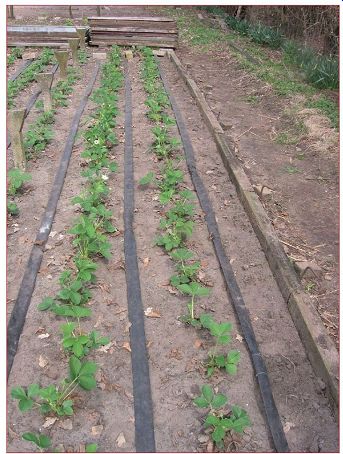
------ Row gardens adapted from commercial agriculture are wasteful of space
and resources on a home scale.
In contrast, intensive mini-farming is three-dimensional. Seeds are planted in the raised bed using within-row spacings in all directions, giving a two-dimensional space, and crops such as pole beans are grown on trellises, adding a third dimension. This vastly increases the quantity of a given crop that can be produced per unit area. In the case of carrots, a garden bed 4 feet wide and 6 feet long (24 square feet) will yield 100 pounds of carrots. That's the theoretical yield, but in practice I've found 32 square feet are required to get a full 100 pounds. Still, that's an amazing increase in space efficiency! Using trellising and pole beans instead of bush beans and indeterminate (vining) tomatoes instead of determinate (bush) tomatoes will also increase the yield per plant.
Using row gardening, the farmer has to fertilize, mulch, weed, and water 300 square feet of space to get 100 pounds of carrots.
But by using raised beds and intensive gardening techniques that use close spacing, the farmer has to fertilize and water only 24 square feet-less than 1/10 the space and thus less than 1/10 the fertilizer and water. The cost savings are immense, and the intensive farmer can also dispense with mulching, because the plants are growing so closely together that they shade each other's stems and the ground, conserving moisture and shading out weeds. The shade provided by growing plants closely is also helpful in protecting beneficial soil microbes from the damaging effects of ultraviolet radiation from the sun. Last season I kept records of how much weeding was required per 100 square feet averaged across crops as diverse as broccoli and tomatoes, and because of the living mulch aspect of intensive gardening, less than 30 minutes per season were required per 100 square feet.
There are three schools of thought regarding the spacing of plants in intensively planted beds. The Grow Biointensive method recommends a hexagonal pattern using various sorts of hexagonal and triangular jigs. The Square Foot method recommends using a grid of squares dividing every square foot into a number of sub-squares appropriate to the spacing of the crop being grown. My own method is to plant a properly spaced row, go up the distance within a row, and then plant seeds in parallel.
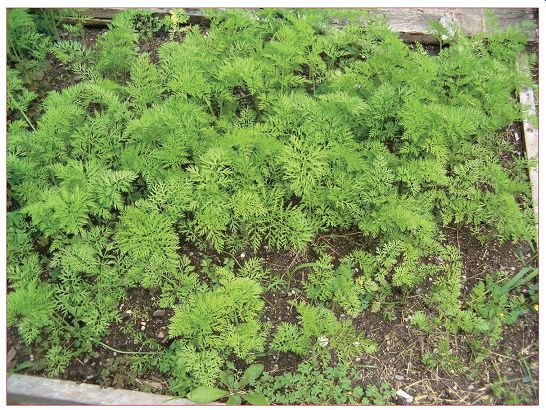
------- Carrots planted intensively in a raised bed yielded 100 pounds
in just 32 square feet.
A little analysis yields a few facts. The Grow Biointensive method actually fits more vegetables into the same space compared to the other two, but for most vegetables the difference is 10% or less.
Offsetting this advantage is the fact that the Grow Biointensive planting method is painstaking and that the average person interested in farming isn't about to envision a hexagon as being composed of a series of equilateral triangles. However , this process will increase yields for a farmer handy enough to set up the proper jigs to make the planting process easy. The jigs are plywood triangles composed of three 60-degree angles and with all three sides the same length as the planting distance between each plant of each different crop. A seed is planted at each of the three points.
The Square Foot method is about as simple as can be imagined geometrically: Everything is a square. Spacing can be figured easily based on within-row spacing of a given plant. The only downside is that you are subdividing individual square feet that need to be laid out within the beds. This works great on a small scale, but on a larger scale this can be problematic, especially when adding large volume soil amendments to beds such as compost. Grids can be made that can be readily removed, but this again is more labor . For a 200-square-foot garden, the work is no big deal, but when the garden is scaled to 6,300 square feet to provide for the needs of a family plus marketable vegetables, the task of making and maintaining grids to set apart individual square feet becomes enormous. Thus the Square Foot method, where each square foot is individually marked off, is more suitable for hobby gardening than a mini-farm.
When I came up with my own way of intensive planting, I wanted something simple enough that my daughter would be able to do it.
First, look at the seed packet to determine the final distance between plants after thinning (circled in the illustration). Second, grab a small ruler and a blunt pencil. Third, use the ruler and pencil to put quarter-inch holes in the ground to mark off a square grid the size of the area you want to plant. The distance between holes is the final distance between plants after thinning. Put a seed in each hole, cover with dirt, and tamp it down-then water daily until the seeds sprout.
Note that all of these methods will eliminate the need to thin plantings. As a result, they conserve seed and thereby conserve money and save labor.
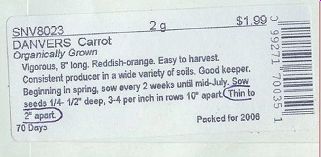
------ Use the final thinning distance as your initial planting distance
for intensive agriculture.
The yield differential for the carrots given in the example isn't atypical. A 100-foot row of lettuce spaced every six inches will fit into a 4-foot × 6-foot intensively planted bed with the same yield.
Comparing the 24 square feet to the 300 square feet (including walking paths), and understanding that an acre contains 43,560 square feet, you will quickly see that a 3,500-square-foot intensive garden will produce the same output as an acre farmed conventionally.
Along with close spacing, intensive agriculture emphasizes vertically grown crops such as cucumbers, vining tomatoes, and pole beans. There are two reasons for this. First, using the third dimension of height allows you to get more production per unit area. Second, vining varieties produce more total food yield over the course of the season. Growing crops vertically on a trellis also makes harvesting easier , reduces diseases, and has the aesthetic advantage of growing consistently straight cucumbers.
So that crops grown on a trellis don't shade out other crops, trellises should be constructed on the north side of raised beds. The ultimate height of a trellis depends somewhat on what is being grown but also on your convenience. For most people, a trellis can be six or even seven feet high without causing inconvenience.
We use a variety of trellis structures including A-frames, boards screwed together , and electrical conduit. Anything will work as long as it is mechanically strong enough to handle winds while fully loaded with plants without falling over.
The approach to intensive agriculture called "mini-farming" in this guide contains elements from many different systems that have been tested by the author at various times. While not every approach can be listed, the most influential systems are described along with some references so that anyone who is interested can learn more about these ideas.
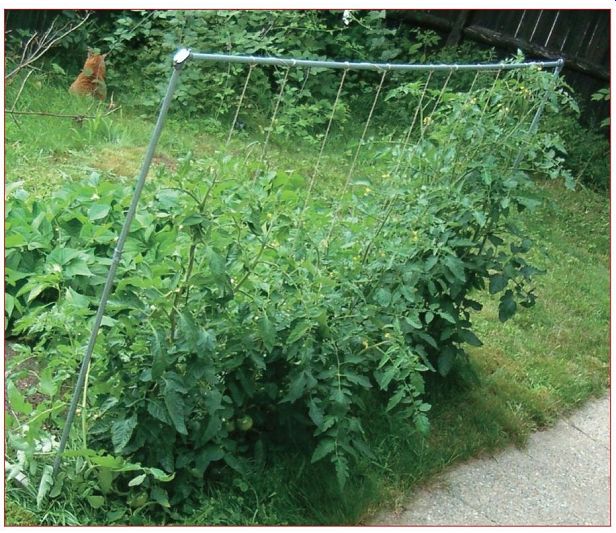
------ Trellises maximize efficiency by allowing plant growth in three dimensions.
The French Intensive method of agriculture was originally developed to cope with the small yard sizes in France. It emphasizes a technique called "double-digging" to create the beds and depends on a considerable input of horse manure for fertilizer . The most comprehensive book on the topic is Intensive Culture of Vegetables by P. Aquatias.
The Biodynamic method was created by Rudolph Steiner in 1924 because of his observations of the detrimental effects of artificial fertilizers. It emphasizes the concept of the farm as a self-contained biological organism. The book What Is Biodynamics? includes seven lectures on the topic by Rudolph Steiner and gives a good overview of the method and its fundamentals.
The Grow Biointensive method is a combination of the French Intensive and Biodynamic methods first synthesized by Alan Chadwick and continued by Ecology Action, a nonprofit group focusing on sustainable agriculture. It keeps the double-dug raised beds of the French Intensive method and adds many aspects of the Biodynamic method. The book How to Grow More Vegetables by John Jeavons covers the method comprehensively.
Square Foot gardening was invented by Mel Bartholomew in the 1980s because of his observations of community gardens and his desire to improve the efficiency and enjoyability of gardening. The method emphasizes the use of raised beds using custom-made soil fertilized with organic amendments. The book All New Square Foot Gardening by Mel Bartholomew covers his methods in detail.
There are other approaches to intensive agriculture with a variety of names, but all of them are essentially composed of elements already incorporated in one of the four methods already listed. The methods of intensive agriculture advocated in this guide are no different-they pull from the experiences of others and add the experience of the author . As a result, the approach that I present differs somewhat from earlier methods. I will explain the reasoning for the differences in the sections ahead, but for now I think it would be worthwhile to point out the major differences.
My mini-farming technique differs from the Square Foot method in that I do not mark off individual square feet of bed or use the bed shape, special soil mix, or individual-plant hand watering techniques advocated by that method.
Mini-farming differs from the Grow Biointensive method mainly in its lack of emphasis on growing grains, but it also dispenses with the seed-starting and plant-spacing methods, among others.
Mini-farming differs from the Biodynamic method in that it doesn't use special herbal preparations for preparing compost, plant seeds by moon phases, or consider the farm to be a self-contained entity.
There are so many other differences, they can't all be listed.
My approach to mini-farming differs from the French Intensive method in that it doesn't rely on massive inputs of horse manure. In other respects the French method is similar to Grow Biointensive, so those differences apply as well.
Learning and Observation
Intensive agricultural practices are constantly being refined, extended, amended, and developed by well-known practitioners and by individual farmers. Agriculture is, at its heart, a biological rather than industrial process. As a result, it is subject to laws of nature that we humans are only beginning to understand. The path to success with intensive agriculture, as with any other endeavor , is through constantly expanding knowledge.
A constant input of new information is most easily and economically acquired through a library. Land-grant universities have a substantial selection of agricultural books and magazines available, and use of the facility is not limited to students. Likewise, the Internet has a wide array of resources available.
Experience is also an excellent teacher, and hands-on experience will provide insight unavailable in a book. Along with gaining experience, a mini-farmer should keep detailed records of events and observations.
We keep several journals for each year . One journal lists every plant variety to be grown that year, where the seed was acquired, and general information about that plant and its requirements. Following this are journal entries describing where, when, and how the seeds were started; transplantation information; and significant events that affected the crop up through harvest. Any pest problems are noted in the journal, along with the effectiveness of any remedies and especially information that might give a clue as to why some plants of a given crop may have been more or less affected.
Another important journal entry specific to intensive agriculture is plant spacing. A starting value for two-dimensional plant spacing is the within-row thinning distance specified on the seed package. This will give optimal yields in a row-type system and will often give optimal yields in a raised-bed intensive system, but a little experimentation is in order because yields relative to spacing will vary with soil and climate conditions. In the case of lettuce in my own garden, I have discovered that eight-inch spacings work better than six-inch spacings-but those results will be different for a different soil and climate.
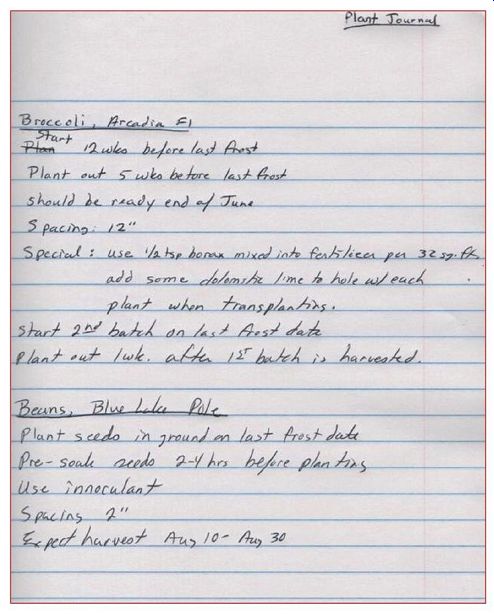
----- Journals are an important tool for learning and improvement.
All of this information helps to fine-tune the environment that I give the plant from year to year so that my reliance on fertilizers, horse manure, and other external inputs-even if organic-can be reduced from year to year.
A journal of crop-specific information also helps me to decide if we want to grow a particular crop variety the next year or perhaps grow it differently. In 2005, we grew a particular kind of carrot that tasted this upcoming year to see how that affects the taste. If my family usually eats carrots when raw, I might want to consider a different variety of carrot altogether . That carrot was also grown in soil that had received some composted horse manure. It would stand to reason that the carrot might taste better raw if grown in a different bed that has been fertilized with only vegetable-based compost.
(And this is the case! Carrots shouldn't be grown in anything close to fresh manure, and we learned this through my journals!) With all of this information, we can fine-tune my carrots until they are the finest quality carrots available.
Another journal that I keep lists weather events, particularly abnormalities or anything that affects crops. Such a journal allows me to know that, in my area, we need to protect young spinach plants from hail when they are planted before the last frost date. Having this knowledge in hand allows my crops to be more productive and suffer less damage.
We also keep a calendar/planner that lets me lay out across the year when we need to perform various tasks-such as starting and transplanting seedlings or harvesting green manures. Such a calendar allows me to see and work around labor bottlenecks in advance. I note in the planner the date of first harvests for each crop based on published maturity dates for the crops, and I make note of instances where a particular crop matured earlier or later than I expected. Predicted harvest dates also allow me to see in advance when succession planting or starting a crop at a time when we ordinarily wouldn't will serve to reduce peak workloads for food preservation so the work can be spread out better.
My final journal lists practically everything I do related to soil fertility, including digging beds, compost contents, organic amendments added to soils, crop rotations, and so forth. This information is correlated with information about harvests of various crops and pest or disease problems.
The idea of all of this journaling is to put all of my experiences and observations into a context that allows me to use that information effectively to make better decisions each year than we made the year before. Working with biological systems is a process of constant learning, and a mini-farmer will ultimately benefit from keeping detailed notes.
Intensive agriculture, because it grows plants close together in a relatively small land area, is a field with a lot of room for experimentation and it makes the results of that experimentation more easily observable by the farmer . This gives mini-farmers an opportunity to make improvements in technique much more rapidly than those involved in industrial farming.